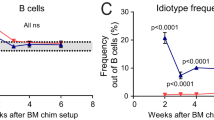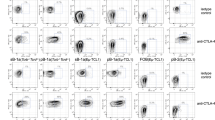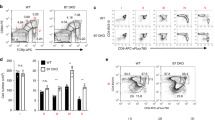Abstract
CpG sequences in self-DNA are an important potential trigger for autoantibody secretion in systemic lupus and other systemic autoimmune disorders. It is not known how this ubiquitous threat may be controlled by active mechanisms for maintaining self tolerance. Here we show that two distinct mechanisms oppose autoantibody secretion induced by CpG DNA in anergic B cells that are constantly binding self-antigen. Uncoupling of the antigen receptor (BCR) from a calcineurin-dependent pathway prevents signals that synergize with CpG DNA for proliferation. The BCR does not become desensitized by activating the extracellular response kinase (ERK) MAP kinase pathway, however, and continuous self-antigen signaling to ERK inhibits CpG DNA–induced plasma cell differentiation. These two mechanisms seem to act as a general control against autoantibody production elicited by Toll-like receptors, and their regulation of T cell–independent responses to Toll-like receptor 9 (TLR9) is probably crucial for resistance to systemic autoimmunity.
This is a preview of subscription content, access via your institution
Access options
Subscribe to this journal
Receive 12 print issues and online access
$209.00 per year
only $17.42 per issue
Buy this article
- Purchase on Springer Link
- Instant access to full article PDF
Prices may be subject to local taxes which are calculated during checkout





Similar content being viewed by others
References
Primi, D., Hammarstrom, L., Smith, C.I. & Moller, G. Characterization of self-reactive B cells by polyclonal B-cell activators. J. Exp. Med. 145, 21–30 (1977).
Coutinho, A. & Moller, G. Editorial: Immune activation of B cells: evidence for 'one nonspecific triggering signal' not delivered by the Ig receptors. Scand. J. Immunol. 3, 133–146 (1974).
Moller, G. et al. Spleen cells from animals tolerant to a thymus-dependent antigen can be activated by lipopolysaccharide to synthesize antibodies against the tolerogen. J. Exp. Med. 143, 1429–1438 (1976).
Steele, E.J. & Cunningham, A.J. High proportion of Ig-producing cells making autoantibody in normal mice. Nature 274, 483–484 (1978).
Dresser, D.W. Most IgM-producing cells in the mouse secrete auto-antibodies (rheumatoid factor). Nature 274, 480–483 (1978).
Izui, S., Eisenberg, R.A. & Dixon, F.J. IgM rheumatoid factors in mice injected with bacterial lipopolysaccharides. J. Immunol. 122, 2096–2102 (1979).
Murakami, M. et al. Oral administration of lipopolysaccharides activates B-1 cells in the peritoneal cavity and lamina propria of the gut and induces autoimmune symptoms in an autoantibody transgenic mouse. J. Exp. Med. 180, 111–121 (1994).
Pisetsky, D.S. Immune response to DNA in systemic lupus erythematosus. Isr. Med. Assoc. J. 3, 850–853 (2001).
Diamond, B. et al. The role of somatic mutation in the pathogenic anti-DNA response. Annu. Rev. Immunol. 10, 731–757 (1992).
Radic, M.Z. & Weigert, M. Genetic and structural evidence for antigen selection of anti-DNA antibodies. Annu. Rev. Immunol. 12, 487–520 (1994).
East, J., Prosser, P.R., Holborow, E.J. & Jaquet, H. Autoimmune reactions and virus-like particles in germ-free NZB mice. Lancet 1, 755–757 (1967).
Wang, H. & Shlomchik, M.J. Autoantigen-specific B cell activation in Fas-deficient rheumatoid factor immunoglobulin transgenic mice. J. Exp. Med. 190, 639–649 (1999).
Julien, S., Soulas, P., Garaud, J.C., Martin, T. & Pasquali, J.L. B cell positive selection by soluble self-antigen. J. Immunol. 169, 4198–4204 (2002).
Hayakawa, K. et al. Positive selection of natural autoreactive B cells. Science 285, 113–116 (1999).
Leadbetter, E.A. et al. Chromatin-IgG complexes activate B cells by dual engagement of IgM and Toll-like receptors. Nature 416, 603–607 (2002).
Bickerstaff, M.C. et al. Serum amyloid P component controls chromatin degradation and prevents antinuclear autoimmunity. Nat. Med. 5, 694–697 (1999).
Taylor, P.R. et al. A hierarchical role for classical pathway complement proteins in the clearance of apoptotic cells in vivo. J. Exp. Med. 192, 359–366 (2000).
Krieg, A.M. et al. CpG motifs in bacterial DNA trigger direct B-cell activation. Nature 374, 546–549 (1995).
Hartmann, G. & Krieg, A.M. Mechanism and function of a newly identified CpG DNA motif in human primary B cells. J. Immunol. 164, 944–953 (2000).
Jung, J. et al. Distinct response of human B cell subpopulations in recognition of an innate immune signal, CpG DNA. J. Immunol. 169, 2368–2373 (2002).
Hemmi, H. et al. A Toll-like receptor recognizes bacterial DNA. Nature 408, 740–745 (2000).
Goeckeritz, B.E. et al. Multivalent cross-linking of membrane Ig sensitizes murine B cells to a broader spectrum of CpG-containing oligodeoxynucleotide motifs, including their methylated counterparts, for stimulation of proliferation and Ig secretion. Int. Immunol. 11, 1693–1700 (1999).
Bretscher, P. & Cohn, M. A theory of self-nonself discrimination. Science 169, 1042–1049 (1970).
Goodnow, C.C. Balancing immunity and tolerance: deleting and tuning lymphocyte repertoires. Proc. Natl. Acad. Sci. USA 93, 2264–2271 (1996).
Nemazee, D. Receptor selection in B and T lymphocytes. Annu. Rev. Immunol. 18, 19–51 (2000).
Li, H., Jiang, Y., Prak, E.L., Radic, M. & Weigert, M. Editors and editing of anti-DNA receptors. Immunity 15, 947–957 (2001).
Seo, S.J., Mandik-Nayak, L. & Erikson, J. B cell anergy and systemic lupus erythematosus. Curr. Dir. Autoimmun. 6, 1–20 (2003).
Erikson, J. et al. Expression of anti-DNA immunoglobulin transgenes in non-autoimmune mice. Nature 349, 331–334 (1991).
Benschop, R.J. et al. Activation and anergy in bone marrow B cells of a novel immunoglobulin transgenic mouse that is both hapten specific and autoreactive. Immunity 14, 33–43 (2001).
Tsao, B.P. et al. B cells are anergic in transgenic mice that express IgM anti-DNA antibodies. Eur. J. Immunol. 23, 2332–2339 (1993).
Xu, H., Li, H., Suri-Payer, E., Hardy, R.R. & Weigert, M. Regulation of anti-DNA B cells in recombination-activating gene-deficient mice. J. Exp. Med. 188, 1247–1254 (1998).
Goodnow, C.C. et al. Altered immunoglobulin expression and functional silencing of self-reactive B lymphocytes in transgenic mice. Nature 334, 676–682 (1988).
Cooke, M.P. et al. Immunoglobulin signal transduction guides the specificity of B cell-T cell interactions and is blocked in tolerant self-reactive B cells. J. Exp. Med. 179, 425–438 (1994).
Healy, J.I. et al. Different nuclear signals are activated by the B cell receptor during positive versus negative signaling. Immunity 6, 419–428 (1997).
Glynne, R. et al. How self-tolerance and the immunosuppressive drug FK506 prevent B-cell mitogenesis. Nature 403, 672–676 (2000).
Dolmetsch, R.E., Lewis, R.S., Goodnow, C.C. & Healy, J.I. Differential activation of transcription factors induced by Ca2+ response amplitude and duration. Nature 386, 855–858 (1997).
Wong, S.C. et al. Peritoneal CD5+ B-1 cells have signaling properties similar to tolerant B cells. J. Biol. Chem. 277, 30707–30715 (2002).
Goodnow, C.C., Brink, R. & Adams, E. Breakdown of self-tolerance in anergic B lymphocytes. Nature 352, 532–536 (1991).
Mansour, S.J. et al. Transformation of mammalian cells by constitutively active MAP kinase kinase. Science 265, 966–970 (1994).
Bowes, T. et al. Tolerance to self gangliosides is the major factor restricting the antibody response to lipopolysaccharide core oligosaccharides in Campylobacter jejuni strains associated with Guillain-Barre syndrome. Infect. Immun. 70, 5008–5018 (2002).
Desai, D.D., Krishnan, M.R., Swindle, J.T. & Marion, T.N. Antigen-specific induction of antibodies against native mammalian DNA in nonautoimmune mice. J. Immunol. 151, 1614–1626 (1993).
Nguyen, K.A. et al. Characterization of anti-single-stranded DNA B cells in a non-autoimmune background. J. Immunol. 159, 2633–2644 (1997).
Rifkin, I.R. et al. Immune complexes present in the sera of autoimmune mice activate rheumatoid factor B cells. J. Immunol. 165, 1626–1633 (2000).
Stollar, B.D. Antibodies to DNA. CRC Crit. Rev. Biochem. 20, 1–36 (1986).
Gilkeson, G.S., Grudier, J.P., Karounos, D.G. & Pisetsky, D.S. Induction of anti-double stranded DNA antibodies in normal mice by immunization with bacterial DNA. J. Immunol. 142, 1482–1486 (1989).
Wang, H. & Shlomchik, M.J. High affinity rheumatoid factor transgenic B cells are eliminated in normal mice. J. Immunol. 159, 1125–1134 (1997).
Goodnow, C.C., Crosbie, J., Jorgensen, H., Brink, R.A. & Basten, A. Induction of self-tolerance in mature peripheral B lymphocytes. Nature 342, 385–391 (1989).
Gilkeson, G.S., Pippen, A.M. & Pisetsky, D.S. Induction of cross-reactive anti-dsDNA antibodies in preautoimmune NZB/NZW mice by immunization with bacterial DNA. J. Clin. Invest. 95, 1398–1402 (1995).
Mandik-Nayak, L. et al. MRL-lpr/lpr mice exhibit a defect in maintaining developmental arrest and follicular exclusion of anti-double-stranded DNA B cells. J. Exp. Med. 189, 1799–1814 (1999).
Rathmell, J.C. et al. CD95 (Fas)-dependent elimination of self-reactive B cells upon interaction with CD4+ T cells. Nature 376, 181–184 (1995).
Deng, C. et al. Decreased Ras-mitogen-activated protein kinase signaling may cause DNA hypomethylation in T lymphocytes from lupus patients. Arthritis Rheum. 44, 397–407 (2001).
Lyons, A.B. & Parish, C.R. Determination of lymphocyte division by flow cytometry. J. Immunol. Methods 171, 131–137 (1994).
Acknowledgements
We thank N. Ahn for the MEK* cDNA, K. Sullivan and the staff of the Medical Genome Center for care and breeding of the transgenic mice and A. Murtagh and S. Ewing for genotyping. C.G.V. is a recipient of a Wellcome Trust International Prize Traveling Fellowship. Supported by a grant from the National Health and Medical Research Council of Australia.
Author information
Authors and Affiliations
Corresponding author
Ethics declarations
Competing interests
The authors declare no competing financial interests.
Rights and permissions
About this article
Cite this article
Rui, L., Vinuesa, C., Blasioli, J. et al. Resistance to CpG DNA–induced autoimmunity through tolerogenic B cell antigen receptor ERK signaling. Nat Immunol 4, 594–600 (2003). https://doi.org/10.1038/ni924
Received:
Accepted:
Published:
Issue Date:
DOI: https://doi.org/10.1038/ni924
This article is cited by
-
Toll-like receptors in lupus nephritis
Journal of Biomedical Science (2018)
-
Intravenous immunoglobulin replacement therapy in common variable immunodeficiency induces B cell depletion through differentiation into apoptosis-prone CD21low B cells
Immunologic Research (2014)
-
Role of molecular mimicry and polyclonal cell activation in the induction of pathogenic β2-glycoprotein I–directed immune response in Balb/c mice upon hyperimmunization with tetanus toxoid
Immunologic Research (2013)
-
BCR-signalling synergizes with TLR-signalling for induction of AID and immunoglobulin class-switching through the non-canonical NF-κB pathway
Nature Communications (2012)
-
Association of toll-like receptor 9 gene polymorphism in Chinese patients with systemic lupus erythematosus in Taiwan
Rheumatology International (2012)



